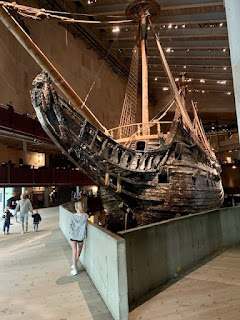The Vasa Museum
There is a good reason why this museum is often on lists of the top museums of the world! And when it comes to lists, the Vasa Museum is always on my list of must-see places to visit in Stockholm... especially when guests ask me what they definitely should not miss when in the city for the first time. Sometimes a guest will comment that they aren't really interested in ships. But the Vasa Museum is so much more! Not only is it impressive, well done and interesting, it is quite unique as well. The museum also shows what life for a sailor was like back in the 1600's, how naval battles were fought, how the ship was found and raised (an amazing engineering feat) and much, much more.
There is a museum in Portsmouth, England featuring the ship the Mary Rose. However, while impressive, only part of the hull of the Mary Rose survived. The Vasa, on the other hand, is almost a complete ship. More than 98% of the ship in the museum is original. And the Vasa is massive... 69 meters long and 52 meters high. It must have been quite an impressive sight as she sailed from Stockholm harbor in 1628, on her way to join the king who was at war in Poland. That is, if she hadn't sunk moments later.
 |
| Artist's rendition of how the Vasa looked leaving the harbor |
You see, while large, beautiful and imposing, the Vasa was flawed. Basically, the center of gravity was too high, making her unstable. When a strong gust of wind filled her sails as she glided out of the harbor, the Vasa tipped and water quickly rushed in via her open gun ports. She sank quickly in front of a large crowd of locals and dignitaries who were gathered on the shore to watch her leave the harbor. Quite the blow to the king's ego and the reputation of the Swedish navy.
While attempts were made, shortly after the Vasa sank, to recover guns and other valuable items... she was slowly forgotten and laid, relatively undisturbed by man, at the bottom of Stockholm harbor for the next three centuries. It was an amateur archaeologist who rediscovered the Vasa in the 1950's. The magnitude of the discovery was quickly apparent and in an amazing feat of engineering, the Vasa was recovered and could be towed to shore, where the museum was built around her.
Now, keep in mind that I am oversimplifying everything here! The actual story of the Vasa, her sinking, recovery and restoration is really fascinating and the museum does a fantastic job at explaining everything in detail. The museum contains several mezzanine levels (looking over the ship) with different exhibitions. From how the Vasa was built to how she is still being restored today. I especially like the explanation of all of the beautiful wood carvings on the ship, what they symbolized and what they would have looked like freshly painted on that fateful day.
 |
| Detailed carving today (right) and what it originally looked like (left) |
Another interesting exhibition takes a look at the human remains found on and around the Vasa when the ship was rediscovered. Thanks to modern science, we are able to know quite a lot about these individuals. Not only how they died but also how they lived, what they ate and worked with and even what they probably looked like. Walking through this exhibition, you come face to face with "Filip", "Adam", "Beata" and others who lost their lives when the Vasa sank. Very C.S.I. Vasa...
The Vasa Museum is located on the island of Djurgården, near other popular Stockholm attractions like Skansen, Gröna Lund and ABBA the Museum... so you can easily spend a full day in the area. Or why not explore the acres of beautiful parklands and forests in the national city park just beyond the attractions? The easiest way to get to the museum from the Hotel Rival is to take the Djurgård Ferry from Gamla Stan (old town), just a ten minute boat ride across the harbor. If you happen to be in the downtown area, then the easiest way to get out to Djurgården is by using the tram.
Side note: I have visited the Vasa Museum many times and I always find it so hard to take pictures that really show how massive the ship is, yet with intricate details. I hope these photos convey this a little bit at least!










Comments
Post a Comment